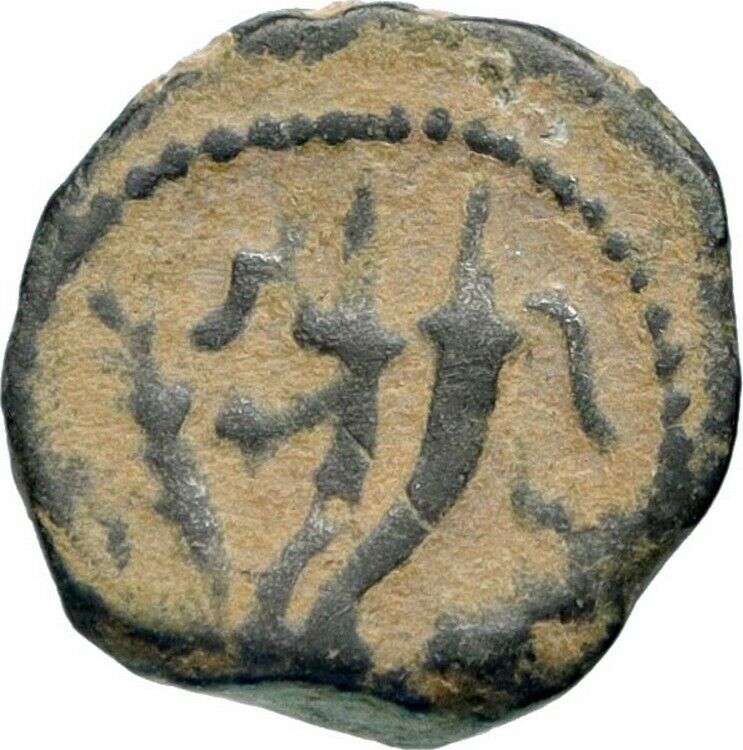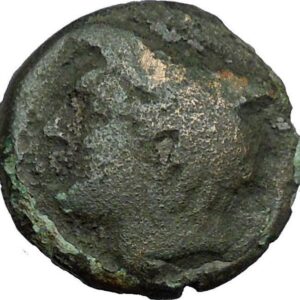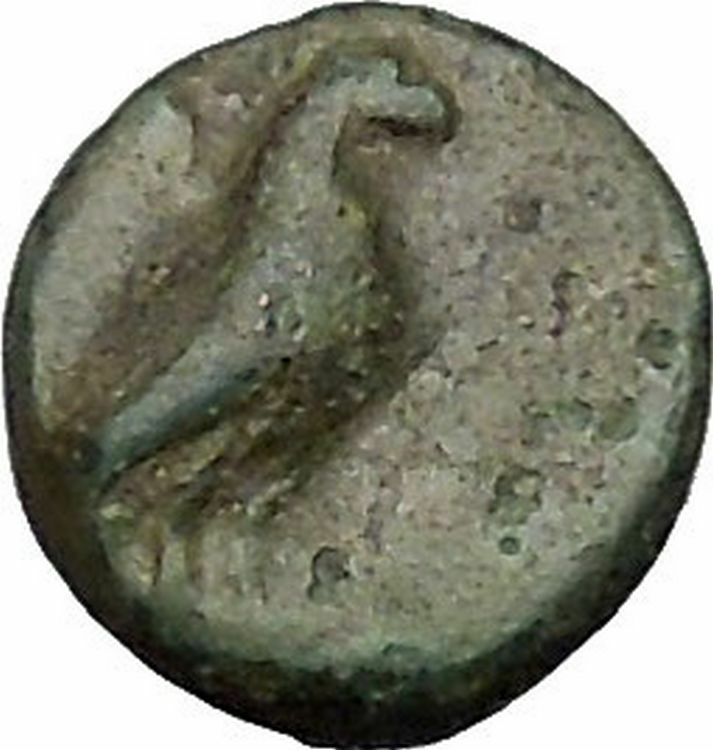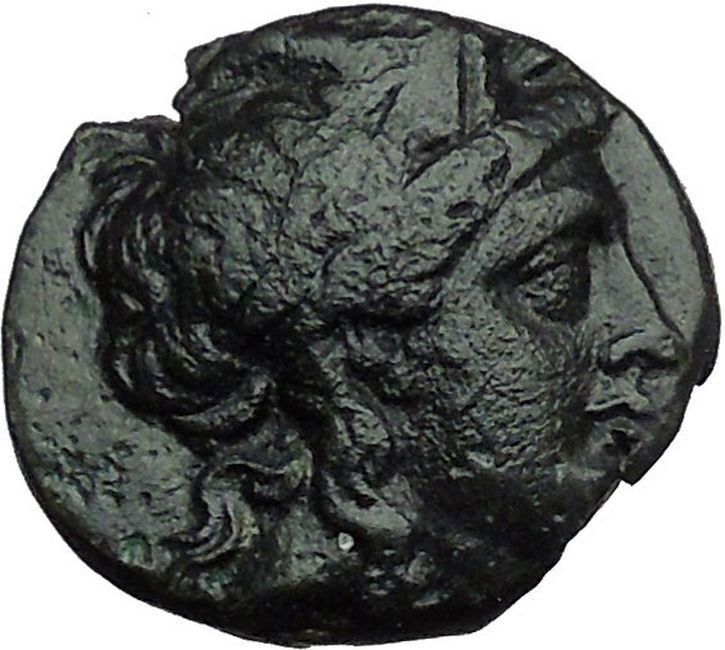|
Greek city of Amorion (Amorium) in Phrygia
Bronze 19mm Struck circa 200-1 B.C.
Sokrates and Aristodes, magistrates.
Reference: SNG Copenhagen 113; SNG von Aulock 3391.
Certification: NGC Ancients Ch F 4285281-098
Laureate head of Zeus right.
ΣΩΚΡΑΤ / ΑΡΙΣΤΕΙΔΟΥ / ΑΜΟΡΙΑΝΩΝ; Eagle standing right on thunderbolt, with kerykeion (caduceus) over shoulder.
You are bidding on the exact item pictured, provided with a Certificate of Authenticity and Lifetime Guarantee of Authenticity.
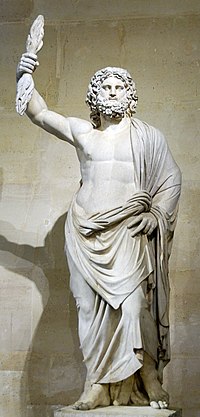 In the ancient Greek religion, Zeus was the “Father of Gods and men” who ruled the Olympians of Mount Olympus as a father ruled the family. He was the god of sky and thunder in Greek mythology. His Roman counterpart is Jupiter and Etruscan counterpart is Tinia. In the ancient Greek religion, Zeus was the “Father of Gods and men” who ruled the Olympians of Mount Olympus as a father ruled the family. He was the god of sky and thunder in Greek mythology. His Roman counterpart is Jupiter and Etruscan counterpart is Tinia.
Zeus was the child of Cronus and Rhea, and the youngest of his siblings. In most traditions he was married to Hera, although, at the oracle of Dodona, his consort was Dione: according to the Iliad, he is the father of Aphrodite by Dione. He is known for his erotic escapades. These resulted in many godly and heroic offspring, including Athena, Apollo and Artemis, Hermes, Persephone (by Demeter), Dionysus, Perseus, Heracles, Helen of Troy, Minos, and the Muses (by Mnemosyne); by Hera, he is usually said to have fathered Ares, Hebe and Hephaestus.
As Walter Burkert points out in his book, Greek Religion, “Even the gods who are not his natural children address him as Father, and all the gods rise in his presence.” For the Greeks, he was the King of the Gods, who oversaw the universe. As Pausanias observed, “That Zeus is king in heaven is a saying common to all men”. In Hesiod’s Theogony Zeus assigns the various gods their roles. In the Homeric Hymns he is referred to as the chieftain of the gods.
His symbols are the thunderbolt, eagle, bull, and oak. In addition to his Indo-European inheritance, the classical “cloud-gatherer” also derives certain iconographic traits from the cultures of the Ancient Near East, such as the scepter. Zeus is frequently depicted by Greek artists in one of two poses: standing, striding forward, with a thunderbolt leveled in his raised right hand, or seated in majesty.
Amorium was a city in Phrygia, Asia Minor which was founded in the Hellenistic period, flourished under the Byzantine Empire, and declined after the Arab sack of 838. It was situated on the Byzantine military road from Constantinople to Cilicia. Its ruins and höyük (‘mound, tumulus’) are located under and around the modern village of Hisarköy, 13 kilometers east of the district center, Emirdağ, Afyonkarahisar Province, Turkey. Amorium is the Latinized version of its original Greek name Amorion (Greek: Ἀμόριον). Arab/Islamic sources refer to the city as ʿAmmūriye. Under Ottoman rule the site, which never regained importance, was called Hergen Kale or Hergen Kaleh.
Antiquity
The city minted its own coins beginning between 133 BC to 27 BC until the 3rd century AD, indicating its maturity as a settlement and military importance during the pre-Byzantine period. Amorium then must have been prestigious and prosperous. But early historical records that mention the city are strictly limited to a reference by Strabo, although it is expected that new discoveries will shed light on the city’s Roman period and before.
Byzantine period
The city was fortified by the emperor Zeno in the 5th century, but did not rise to prominence until the 7th century. Its strategic location in central Asia Minor made the city a vital stronghold against the armies of the Umayyad Caliphate following the Muslim conquest of the Levant. The city was first attacked by Muawiyah I in 646. It capitulated to ‘Abd ar-Rahman ibn Khalid in 666 and was occupied by Yazid I in 669, then retaken by Constans II’s general Andreas. Over the next two centuries, it remained a frequent target of Muslim raids (razzias) into Asia Minor, especially during the great sieges of 716 and 796. It became capital of the thema of Anatolikon soon after. In 742-743, it was the main base of Emperor Constantine V against the usurper Artabasdos, and in 820, an Amorian, Michael II, ascended the Byzantine throne, establishing the Amorian dynasty. This began the period of the city’s greatest prosperity, when it became the largest city in Asia Minor. Its status however as the native city of the reigning dynasty also spelled its doom: in 838, the Caliph Al-Mu’tasim launched a campaign specifically against the city, which was captured and razed, an episode recounted in a poem of Abu Tammam.
The town was rebuilt, but was burned by Thamal al-Dulafi in 931. Nonetheless, it remained an active Byzantine city at least into the 11th century. Following the Battle of Manzikert, it was devastated by the Seljuks and a large proportion of its inhabitants were killed. Emperor Alexios I Komnenos defeated the Seljuks at Amorium in 1116, but the area was never recovered.
It remained an important place in the 12th-14th centuries according to al-Idrisi and Hamdallah Mustawfi.
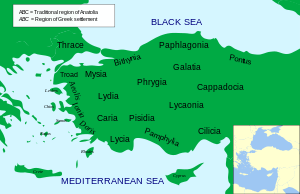 In antiquity, Phrygia was a kingdom in the west central part of Anatolia, in what is now Turkey, centered on the Sakarya River. In antiquity, Phrygia was a kingdom in the west central part of Anatolia, in what is now Turkey, centered on the Sakarya River.
During the heroic age of Greek mythology, several legendary kings were Phrygians: Gordias whose Gordian Knot would later be cut by Alexander the Great, Midas who turned whatever he touched to gold, and Mygdon who warred with the Amazons. According to Homer’s Iliad, the Phrygians were close allies of the Trojans and participants in the Trojan War against the Achaeans. Phrygian power reached its peak in the late 8th century BC under another, historical, king: Midas, who dominated most of western and central Anatolia and rivaled Assyria and Urartu for power in eastern Anatolia. This later Midas was, however, also the last independent king of Phrygia before its capital Gordium was sacked by Cimmerians around 695 BC. Phrygia then became subject to Lydia, and then successively to Persia, Alexander and his Hellenistic successors, Pergamon, Rome and Byzantium. Phrygians were gradually assimilated into other cultures by the early medieval era, and after the Turkish conquest of Anatolia the name Phrygia passed out of usage as a territorial designation.
|









 In the ancient Greek religion, Zeus was the “Father of Gods and men” who ruled the Olympians of Mount Olympus as a father ruled the family. He was the god of sky and thunder in Greek mythology. His Roman counterpart is Jupiter and Etruscan counterpart is Tinia.
In the ancient Greek religion, Zeus was the “Father of Gods and men” who ruled the Olympians of Mount Olympus as a father ruled the family. He was the god of sky and thunder in Greek mythology. His Roman counterpart is Jupiter and Etruscan counterpart is Tinia. In antiquity, Phrygia was a kingdom in the west central part of Anatolia, in what is now Turkey, centered on the Sakarya River.
In antiquity, Phrygia was a kingdom in the west central part of Anatolia, in what is now Turkey, centered on the Sakarya River.

